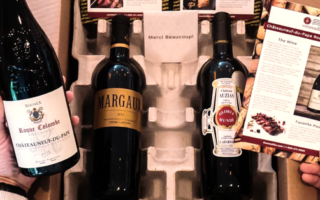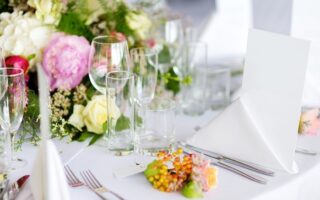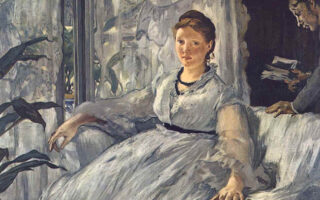Cháteauneuf du Pape

- SUBSCRIBE
- ALREADY SUBSCRIBED?
BECOME A BONJOUR PARIS MEMBER
Gain full access to our collection of over 5,000 articles and bring the City of Light into your life. Just 60 USD per year.
Find out why you should become a member here.
Sign in
Fill in your credentials below.
The 2003 vintage of wines from Châteauneuf du Pape is a wine with which to e reckoned. It’s a good time for a look at this well known and generous wine from a vintage year made difficult by extreme heat throughout France. That opportunity came last March at the Washington, D.C. International Wine and Food when I compared tasting notes with exhibitor Alain Junguenet and then attended a formal tasting of these wines over which he presided.
First, Mr. Junguenet confided some general notes about the wines. He noted that Châteauneuf du Pape is the second largest vineyard area in France after St.-Emilion. Cultivation of grapes goes back to the time of the Romans. There are no grands crus or premiers crus. The name for the region comes from the 14th-century move of the Papacy to Avignon and the consequent need for a summer papal enclave to escape the Avignon heat. That castle, he said, was largely destroyed “by mistake” in an Allied bombing raid in 1944, although the Clos des Papes winery recalls the location.
The wines should age at least five years in the bottle and eight to ten years in magnum bottles, a size that he preferred. Châteauneuf du Pape is a blend of up to 13 different grape varieties. (If you use Grenache Blanc, he said, perhaps implying that some producers do use it, the total of authorized grapes in the final blend would rise to 14). Amongst the commonly used grapes, there is Grenache for balance, Syrah for color and fruit aromas, Morvèdre for spices and tannins, and the white grapes Clairette for finesse, Grenache Blanc for richness, and Roussane for suppleness.
Grenache is the predominate grape, amounting to 80% of the Châteauneuf du Pape blend. There is no requirement for percentages of grape varieties. Chateau Beaucastel, for example, which uses all 13 permitted grape varieties in its celebrated wine, uses only 30% Grenache (the smallest proportion of the major producers), while Château Rayas Châteauneuf du Pape is 100% Grenache.
The harvesting and fermentation processes are now refined with modern temperature controls here as elsewhere in France. In the more leisurely years past, the grapes would be harvested and then they would be left to ferment for a  month or so while the vineyard owners went off for the hunting season! The aromas of the wine evolve over time. Early on, fruit aromas will predominate, such as cherry or blackberries. Then gradually this will be replaced by spicy aromas, such as nutmeg, pine, or bay leaf. A fully mature Châteauneuf du Pape might have a hint of the aroma of truffles, he said. (I have noticed that a number of Côte d’Or Burgundy wines go through a similar progression.) Most Châteauneuf du Pape wines are unfiltered and not even fined in order to keep their robust, original complexity.
month or so while the vineyard owners went off for the hunting season! The aromas of the wine evolve over time. Early on, fruit aromas will predominate, such as cherry or blackberries. Then gradually this will be replaced by spicy aromas, such as nutmeg, pine, or bay leaf. A fully mature Châteauneuf du Pape might have a hint of the aroma of truffles, he said. (I have noticed that a number of Côte d’Or Burgundy wines go through a similar progression.) Most Châteauneuf du Pape wines are unfiltered and not even fined in order to keep their robust, original complexity.
Some white Châteauneuf du Pape wine is produced, perhaps 5-6% of the total. Contrary to belief, we know from pleasant experience that it can age very well, acquiring rounded flavor and complexity. It would make wonderful dinner conversation to serve both white and red Châteauneuf du Pape wines from the same vintage.
Mr. Junguenet praised the 1988, 1989, and 1990 vintages as very fine and he liked both the 1998 and the 1999. The 2000 vintage was “exceptional,” while the 2002 was “a catastrophe.” (So much for picking up a few bottles of 2002 on sale as our retailer tries to empty the shelves for the 2003 vintage.) The 2003 was, he thought, an exceptional vintage. I asked about the role of individual grape varieties in producing an outstanding year. It stands to reason that fine vintages tend to be those that produced outstanding grape varieties of the blend. He notes that in 1978, 1998, and 2001 the Grenache was particularly successful, while in 1999 the Mourvedre was excellent. Of course, 1978 is something of a benchmark for excellence in Châteauneuf du Pape. We greatly enjoyed half a case over as many years and then sold (with some regret) at auction the remaining six bottles for ten times their original retail price.
On the question of the 2003 vintage overall, Mr. Junguenet said that the region is so inured to very hot weather that this vintage was not very unusual. Particularly for those many châteaux that use vieilles vignes, the grapes will be well established with roots that years ago descended to depths near the water table. In general, the wines would not have suffered from the heat. Some of the leading grape varieties even prefer it.
Here are tasting notes from the wines presented. Each wine, he said, should retail for $35-$40 a bottle with the exception of some special cuvées such as Boislauzon Cuvée du Quet, which would cost in the neighborhood of $65-$70. The alcoholic content of this wine is usually 13-13.5%. As befits wines produced in a more generous style, the alcoholic content for the 2003 vintage sometimes exceeded 14%. The tannins are rather large and predominant, arguing for more cellaring time than usual for the wines to reach full development.
Bousquet des Papes (75% Grenache, 11% Mourvèdre, 9% Syrah). This wine comes from a traditional famiy estate that has produced the wine over ten generatons. Spicy and peppery, the wine was quite tannic, but showed nice fruit, a “traditional” Châteauneuf du Pape at 13.5% according to Mr. Junguenet. I greatly preferred the pricier Bousquet des Papes Vieilles Vignes Chante le Merle (Blackbird Sings), which was very flavorful and in a lighter style at 13%.
Château Fortia (33% Grenache, 34% Syrah, 33% Mourvèdre). This estate took a lead in establishing the present legal requirements for the wine, including the 13 authorized grapes for the blend. This was a huge wine at 14.5% alcohol, reserved and full of tannins, a wine to cellar for the future.
Domaine de la Côte de l’Ange (70% Grenache, 15% Syrah, 10% Mourvèdre). This wine promses to be well balanced, with assertive tannins now. Fruit holding up well.
Domaine des Relagnes (80% Grenache, 10% Syrah, 10% Mourvèdre and Cinsault). Good color and very fruity.
Domaine Moulin-Tacussel (80% Grenache, 10% Syrah, 7% Mourvèdre). Very elegant. Fruity aroma rather than peppery.
Domaine Pierre Usseglio & Fils (75% Grenache, 10% Syrah, 6% Mourvèdre). Another traditional family-owned property. This was a fruity and balanced wine and was one of my favorites of the tasting.
Domaine J.P. Lafond Roc-Epine (80% Grenache, 10% Syrah, 10% Mourvèdre). This was quite a spicy, peppery, traditional wine, very tannic at this early stage. They are just a four-acre estate and also produce rather a nice rose wine.
Mas de Boislauzon (80% Grenache, 10% Syrah, 10% Mourvèdre). Fruity, although tannins predominate at this stage. Smooth and very well made, a favorite, 13% alcohol. Cuvée du Quet is an unfiltered wine, produced by the family’s younger generation from nearly all Grenache grapes on one small parcel of land. At 13%, the wine is very fine and sufficiently tannic. It should become very elegant over time. A favorite.
Le Vieux Donjon (70% Grenache, 20% Syrah, 10% Mourvèdre & Cinsault). This is well balanced and elegant wine, a favorite, and a classic Châteauneuf du Pape. Very dark, at 13.5%, a huge wine in the making. (I was told that this property makes a very fine white Châteauneuf du Pape from Roussane vieilles vignes.)
Domaine de l’Hospice. This wine is produced from charitable donations. Tannic at 14.5%, promising for the future.


